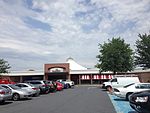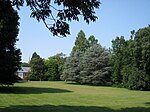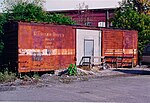Christian Habeck Farm

Christian Habeck Farm, also known as the Abraham Brubaker Farm, is a historic farm and national historic district located at East Hempfield Township, Lancaster County, Pennsylvania. The district includes 12 contributing buildings. They include the brick farmhouse, a frame Pennsylvania bank barn (1869), spring house (c. 1876), two frame tobacco barns (c. 1920), a brick tenant house (c. 1880), a summer kitchen (c. 1876), a pigsty (c. 1900), a milk house, and a creamery (c. 1910). The farmhouse dates to the mid-to-late-19th century. It is a 2 1/2-story, rectangular brick dwelling, with a full-width front porch.It was listed on the National Register of Historic Places in 1994.
Excerpt from the Wikipedia article Christian Habeck Farm (License: CC BY-SA 3.0, Authors, Images).Christian Habeck Farm
Spring Valley Road, East Hempfield Township
Geographical coordinates (GPS) Address External links Nearby Places Show on map
Geographical coordinates (GPS)
| Latitude | Longitude |
|---|---|
| N 40.061388888889 ° | E -76.364444444444 ° |
Address
Christian Habeck Farm
Spring Valley Road 2301
17554 East Hempfield Township
Pennsylvania, United States
Open on Google Maps








